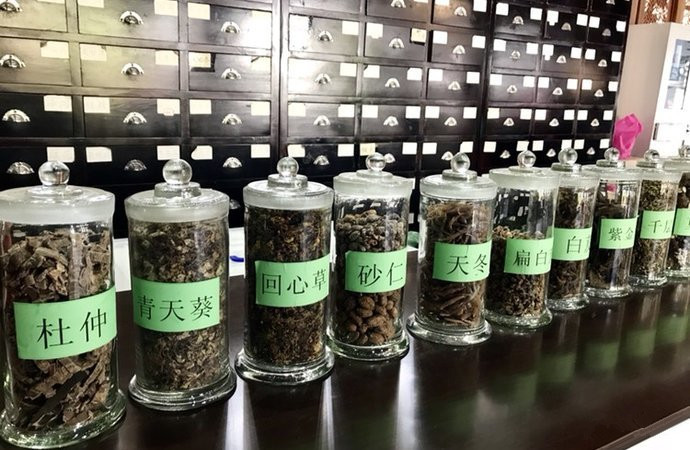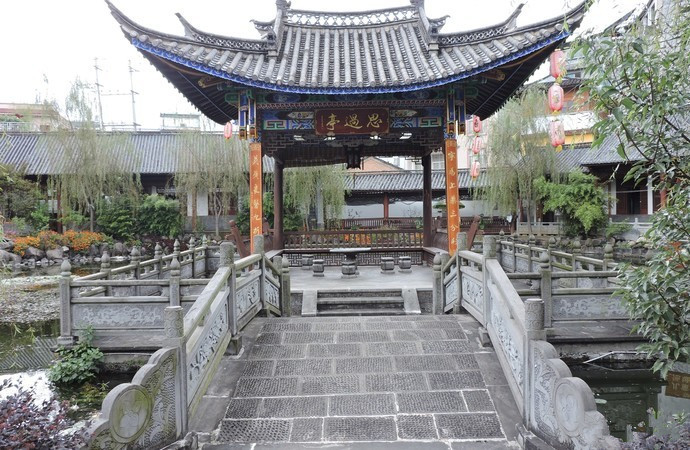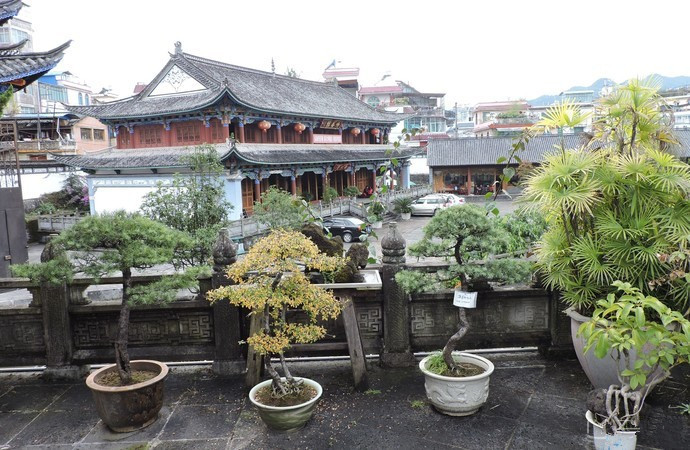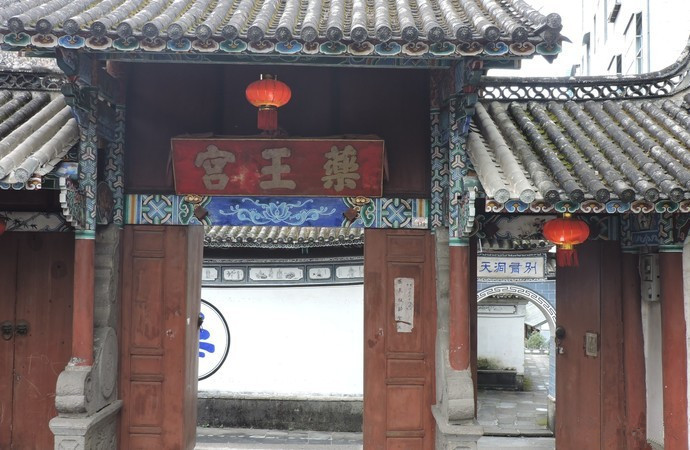
Palace of Medicine King in Tengchong County, Baoshan
Chinese Name:腾冲市药王宫
English Name: Palace of Medicine King in Tengchong County, Baoshan
The Palace of Medicine King (药王宫) is a renowned cultural and historical site located in Tengchong City (腾冲市), Baoshan City (保山市), Yunnan Province (云南省). It was originally named Qinghui Palace (清徽宫) and was established in 1626 during the Ming Dynasty (明朝) by the famous physician Li Zhongchun (李仲春). The palace honors the medical achievements and contributions of 13 generations of renowned physicians throughout history.
Occupying an area of 8,700.66 square meters, the palace features a unique architectural layout symbolizing the principles of traditional Chinese medicine, including the use of the gourd shape to represent healing and benevolence.
In 2019, the Yunnan Provincial People’s Government (云南省人民政府) declared the Palace of Medicine King as a provincial cultural relic protection unit, acknowledging its significance as a cultural heritage site.
Historical Development
The Origins of the Palace
The Palace was first proposed and built by Li Zhongchun (李仲春), a military physician who participated in the campaign to stabilize the region during the Ming Dynasty. As the story goes, Li Zhongchun and other renowned local doctors and philanthropists contributed funds and resources to the project, which was completed in 1626. The main purpose of the palace was to honor ancient medical practitioners, including those from the time of the Three Sovereigns and Five Emperors (三皇五帝).
Reconstruction and Expansion
During the Qing Dynasty (清朝), the palace underwent significant renovations and expansions. In 1725, the Five Emperors Pavilion (五帝楼) was added, which led to the palace taking on the distinctive gourd shape that symbolized both medical care and healing. The palace was damaged during conflicts but was rebuilt in 1887 and again in 1925 during the Republic of China period (民国时期).
Architectural Layout
The Palace of Medicine King is situated at the northwest corner of the ancient city walls of Tengchong, with its grounds following a sloping terrain from east to west. The entire layout of the palace is designed to resemble a gourd, symbolizing the ancient Chinese concept of healing and health.
Key Structures
Main Gate (宫门):
The main gate is a traditional wooden structure with a three-bay design. It faces east and measures 7.5 meters in width. The gate is supported by two large drumstones, which are often used in Chinese architecture for decorative purposes.
Hall Building (厅楼):
The hall building is a single-pitched roof wooden structure, with three bays and a width of 11.25 meters. The building serves as the main entrance to the Qingwei Palace (清微宫) or Medicine King Hall (药王殿).
Qingwei Palace (清微宫):
The Medicine King Hall is located on a raised platform, with a single-pitched roof and a three-bay design. It houses statues of the 13 famous physicians who have been honored throughout the history of the palace.
Five Emperors Pavilion (五帝楼):
This is a double-eaved, Xieshan roof structure, built on a high platform. The pavilion houses statues of the Three Sovereigns (三皇) and Five Emperors (五帝), legendary figures in Chinese history, who are revered as ancestors of the Chinese people.
Think-over Pavilion (思过亭):
A pavilion with an inscription that reads: “It is better to earn three parts of profit from superior medicine than to lose the trust of patients with minor faults.” The pavilion was originally named Regret Pavilion and was later renamed to Think-over Pavilion, symbolizing a moral reminder for pharmacists to maintain integrity.

Historical and Cultural Significance
The Legacy of Sun Simiao (孙思邈)
The Palace is dedicated to Sun Simiao, known as the Medicine King Bodhisattva (药王菩萨), who was a renowned physician of the Tang Dynasty (唐朝) and is considered one of the most important figures in the development of traditional Chinese medicine. Sun Simiao is famous for his contributions to pharmacology and his comprehensive medical writings, particularly the Qianjin Yaofang (千金药方). He emphasized the importance of prevention in medicine, which aligns with modern medical practices.
The Palace of Medicine King continues to honor Sun Simiao as a symbol of medical benevolence, and his influence is evident in the structure and ethos of the palace.
Annual Celebrations
Every year on the 28th day of the 4th lunar month, the Birthday of Medicine King is celebrated in grand fashion at the Palace. This event includes various rituals and offerings to honor the contributions of past and present medical practitioners.
Cultural Relics and Artifacts
The Palace of Medicine King holds a collection of important cultural relics, including statues and historical medical texts, which reflect the development of traditional Chinese medicine over the centuries. These relics not only document the local history of Tengchong (腾冲) but also the evolution of the broader Yunnan (云南) medicinal practices.
The palace also houses a museum dedicated to the pharmaceutical history of Tengchong, featuring various medical products, herbs, and tools used in traditional practices, showcasing the region’s rich medicinal heritage.

Protection and Preservation
Cultural Heritage Protection
The Palace of Medicine King was officially listed as a provincial-level cultural relics protection unit by the Yunnan Provincial People’s Government in 2019. Efforts are continuously made to preserve the architecture and the historical significance of the site, which is crucial to the understanding of the local medical heritage.
Ongoing Development
In 2012, the Tengchong County Traditional Chinese Medicine Development Research Association was established, with its headquarters located within the Palace of Medicine King. The association works to preserve and promote traditional Chinese medicine, and the palace now serves as a central hub for educational and cultural activities related to Tengchong’s medicinal history.

Visitor Information
Location
The Palace of Medicine King is located at the western end of Guanghua Street (光华街) in Tengchong City (腾冲市), near the northwest corner of the ancient city wall.
Transportation
Train: Visitors can travel by train to Baoshan (保山) and then take a tourist bus to Tengchong. The train ride from Dali (大理) to Baoshan takes approximately 1.5 hours, while the journey from Kunming to Baoshan takes about 3.5 hours.
Tourist Bus: Direct buses from Kunming to Tengchong can be taken at Kunming West Bus Station. Similarly, buses are available from Dali to Tengchong at Dali Fast Passenger Station.
Visiting Hours
Opening Hours: Open daily.
Admission: Entry is free, though donations are appreciated.

 7 Days GolfingTour
7 Days GolfingTour
 8 Days Group Tour
8 Days Group Tour
 8 Days Yunnan Tour
8 Days Yunnan Tour
 7 Days Shangri La Hiking
7 Days Shangri La Hiking
 11 Days Yunnan Tour
11 Days Yunnan Tour
 6 Days Yuanyang Terraces
6 Days Yuanyang Terraces
 11 Days Yunnan Tour
11 Days Yunnan Tour
 8 Days South Yunnan
8 Days South Yunnan
 7 Days Tea Tour
7 Days Tea Tour
 8 Days Muslim Tour
8 Days Muslim Tour
 12 Days Self-Driving
12 Days Self-Driving
 4 Days Haba Climbing
4 Days Haba Climbing
 Tiger Leaping Gorge
Tiger Leaping Gorge
 Stone Forest
Stone Forest
 Yunnan-Tibet
Yunnan-Tibet
 Hani Rice Terraces
Hani Rice Terraces
 Kunming
Kunming
 Lijiang
Lijiang
 Shangri-la
Shangri-la
 Dali
Dali
 XishuangBanna
XishuangBanna
 Honghe
Honghe
 Kunming
Kunming
 Lijiang
Lijiang
 Shangri-la
Shangri-la
 Yuanyang Rice Terraces
Yuanyang Rice Terraces
 Nujiang
Nujiang
 XishuangBanna
XishuangBanna
 Spring City Golf
Spring City Golf
 Snow Mountain Golf
Snow Mountain Golf
 Stone Mountain Golf
Stone Mountain Golf















